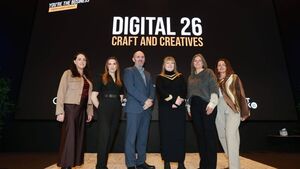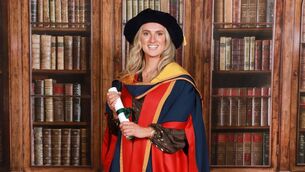Local businesses get cutting edge look at AI

At the introdduction to AI event iat Google's Dublin HQ were Kay Lyng (K Kajoux Jewels), Cera Ward (Google Ireland), Kieran Comerford (chair of the Network of Local Enterprise Offices), Kim Whyte (Pawpear), Magdelena Seymour (Pure Oskar) and Niav Riley (Market Square Studios)
LOCAL creative businesses are feeling positive yet apprehensive about using AI in their work processes after attending a Carlow Local Enterprise Office event at Google headquarters in Dublin.
“It was good to see what can be done,” said Leslie Kelly of 5th Wall Interiors. “Google is improving all the time; things are moving so fast. It was good to see what’s coming down the line.” But “some of it went absolutely over my head”, Ms Kelly said with a laugh.
The event on 13 November was organised to show how digital tools and artificial intelligence (AI) can support growth in creative enterprises. Kira Brakhage from Google delivered a presentation on applying AI to improve productivity, content development and discover new market opportunities. John Stafford from Google showed how ViGenAir can repurpose existing content into promotional video assets for different advertising platforms.

Two workshops – making sense of AI and practical AI for marketing – followed.
The closing session was a panel discussion with business leaders sharing how digital thinking and AI inform their product development and day-to-day operations.
Naomh McElhatton, Irish ambassador for Women in AI and founder of the Business of AI Club, monitored the panel of Magdelena Seymour of Pure Oskar, Kim Whyte of Pawpear, Kay Lyng of K Kajoux Jewels, Niav Riley of Market Square Studios, and Kieran Comerford on behalf of the local enterprise offices.
Paul Byrne, who owns and operates PB Studio in Carlow, said: “It was a really well-run event.”
“We’re lucky to have an event like this. Many other European countries don’t have Google on their doorstep.”
However, he understood that it could sometimes be daunting for small businesses to upskill in this way. “We’re doing so much as company owners anyway. The big question is where to start.”
For Mr Byrne and his colleagues, the advent of AI is not overwhelming: “We’re driven by innovation as a studio. We see it as an innovation tool rather than a threat.” After the event, they are looking to use Google’s NotebookLM more intensively, to get greater insights into buying trends of their customers and aid their sales process. “We’re embracing it; we’re definitely not afraid of it.”
Leslie Kelly found it difficult to imagine how AI could threaten her business, but saw it as being potentially useful for social media and scheduling. She expressed fears about privacy and intellectual property ownership. “The biggest thing was copyright. They couldn’t answer questions about who owns it,” she noted.
Similarly, Pat Bramley, owner of Bramley Jewellers, “couldn’t get a handle on how secure AI is” or how much it really costs to implement.
Phillip, the jewellery maker, uses AI in his laser printing machinery, he said, and is hoping to upscale it in the new year.
AI “certainly is the coming thing”, said Mr Bramley. “It’s the only way to go now.”





